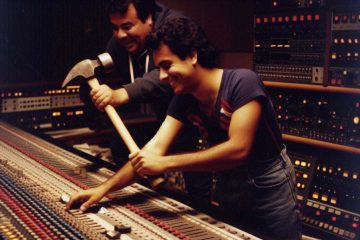Is my mix ready for mastering? This is a tough one to answer however if you check these 5 things before sending off those mixes you’ll be closer to being done than not:
1. The Right Format
You absolutely want to send your mix as a stereo .wav or .aiff 24 bit file. Preferably at 44.1kHz or higher. Mp3s aren’t really a high resolution format but if for some reason that is all you have they can be used as a last resort.
2. Pops, Clicks & Edits
The last thing you want to hear on Spotify once the final master is uploaded is a singer breath cut in half or poorly crossfaded.
I know it’s a drag but going over you regions, especially the vocals, and checking that they have been faded in or out or crossfaded if a region is overlapping is such a simple thing but can make a significant difference. A bad edit that you miss will make you regret rushing this step. Check those edits and tidy them.
3. Tame The Percussion Lion
Nothing sucks up dynamic range like percussive sounds. Sure it can be tamed at the mastering stage but now its compromising the rest of the mix.
Check percussive elements and tame those dynamic peaks. This is especially true for most pop, rock, metal and indie music. If it has drums and you want it to be comparably loud to other songs released commercially then using some limiting and compression to tame those peaks will make a big difference.
4. Get Out Of The Room
Step outside the room you’re listening in and take note of the volume of the vocal in the mix (if it’s not instrumental). Listen for the snare too, then the kick drum, then the bass guitar and then other elements of the mix. Do any stand out clearly? They probably need to be turned down a dB or two. Could also be an EQ thing. The “outside the room” trick really helps give you perspective on the balance of the mix.
5. Mono Check 1, 2 …
Check your mixes in mono. Most “fuller” frequency systems are stereo but a large number of smartphones are not. If you’ve got something funky going on in mono people will hear it (just happened to me tonight). Plus it’s just another good way to get more perspective on your mixes.
Bonus Tip: Get Your Mixes Really Ready For Mastering
Check your mix in multiple listening environments. Use headphones, car stereos, smartphone speakers, bluetooth speakers etc. Don’t try and mix for each listening environment but look for a good average where the mix is represented well on each.
Particularly listen to the mixes on a small speaker, bluetooth and smartphone. Why? Can you hear the bass? Maybe it needs a little more sculpting with EQ or some point from some saturation to translate to smaller speakers. Don’t go overboard, it’s always a compromise.
Is the bass blowing out the song on the small speaker? Maybe you need to tame that bottom end on the kick, bass or a synth part. Maybe there is sludgy mud build up in the 200 – 300 Hz range? Try turning the speaker or phone volume so it’s just audible and seeing what the balance is like of all the instruments. What is most prominent? Probably should be the vocal and snare, possibly a secondary melodic part should be there a little quieter too.
There are many more things I could list (and I’ll add more) but these will definitely help get your mixes much closer to being ready for mastering. Leave your thoughts, comments, suggestions below in the comments.
Other information to get your mixes ready for mastering:
- 13 Quick Tips for Preparing a Mix for Mastering a really great indepth article about how to prepare your mix for mastering.
- So You Think You’ve Finished Mixing? A Guide to Preparing Your Mix for Mastering all great points but Step 3 about not dithering your mixes is really important.
- How To Prepare A Multitrack Mix For Mastering a no nonsense step-by-step guide to actually exporting the file to send to a mastering engineer.
Do you need online mixing or mastering? Use the contact form to get in touch and tell me more about your project.



0 Comments